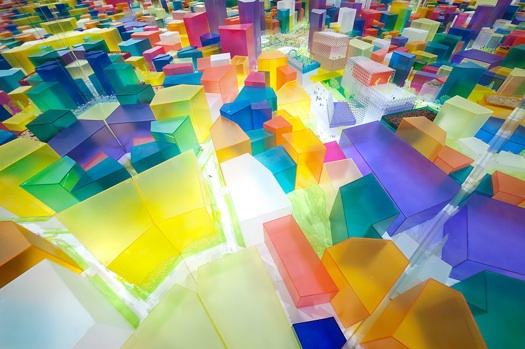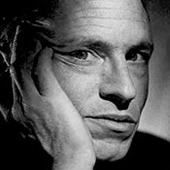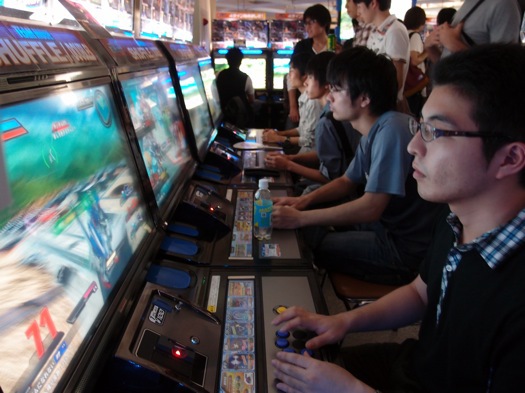
November 21, 2011
Audi Urban Future Summit 2011

Alison Brooks Architects, Vision of the City, Audi Urban Future Award 2010
Audi’s Urban Future Summit was held to coincide with the big Frankfurt Auto show in mid-September, when acres of new cars were spread out for press and public in a space so huge that, ironically, visitors often resorted to bicycles to see the whole fair.
The event gathered together some 500 planners, architects, engineers, designers, scientists and futurists. Audi brought in and housed experts in economics, sociology and the natural sciences, along with figures from a specially established board of experts called the Audi Think Tank.
This conference is part of a wider Audi Urban initiative — a look at the future of the city, with an eye to transportation. Launched last year, it is about mobility and megacities.
The larger program included the competition for visions of future urban mobility, the Audi Urban Future Award 2010, involving five internationally known architecture teams, including Bjarke Engels, Jürgen Mayer H and Alison Brooks. The resulting projects were shown at the architecture biennale in Venice, and elements of them were rendered in workshops by local teams “redesigning New York” under Audi sponsorship at last spring’s New Museum–hosted Festival of Ideas for the New City.
Audi’s partnership with the New Museum might be said to compete with BMW’s relationship with the Guggenheim, whose open studio on the Lower East Side invited public participation — a role-playing game of urban planning called Urbanology, for instance, a restaurant, and a schedule of presentations. Other pavilions will be set up in other cities.
Both of the programs grow from the auto companies’ recognition that — especially among the urban young — automobiles have a negative image. One Wall Street analyst even describes the industry’s reputation as a “tobacco-like” problem.
The automobile, of course, is only one piece in the vast network of streets and highways, fuel, parking, insurance and policing. In the past, it has been hard enough to get car companies to look at the total system. But the interest and indeed fear on the part of the German executives seem real. Both the Audi program and conferences and BMW’s Guggenheim effort have shown some pretty interesting visions that are far from car-friendly.
The conference suggested that Audi planners have genuine concerns about the future — if for no more philanthropic reason than that their business is at stake. As companies like Kodak or Hewlett-Packard rethink their core businesses, car manufacturers have even deeper worries. Once General Motors showed images at world’s fairs of more and more cars. But at Expo 2010 in Shanghai, the General Motors pavilion displayed an urban world of Segway-like personal transporters, called PUMAs. Networked by a system designed by the MIT Media Lab, these vehicles were proudly featured later at auto shows.
Audi’s conference even more explicitly raised questions about the future of the car and those who make it: will Audi and other automotive companies even build cars in the future? What will their products be if they want to stay in the mobility business? (IBM quit making PCs but is still in the information business.)
The headliners included the sociologist Richard Sennett, who began by invoking the systems theory of Norbert Wiener and emphasized the need for open systems in the city and the “noise” of fresh inputs. Carlo Ratti, director of MIT’s SENSEable City Lab, described, as many optimistic urban visionaries do today, a city wired and sensored for smoother traffic flow, easier parking and less conflict between car and pedestrian. Even garbage can be RFID-tagged and traced, he says. The pop futurist Charles Leadbeater offered up the useful idea of empathic systems in the city that bolstered warm human relationships as well as efficient networks for delivering products and services (he offers farmers’ markets as an example of such systems enacted on a small scale). Ludger Hovestadt, of the Swiss Federal Institute of Technology in Zurich, painted a picture of a future dominated by the cultivation of solar power as a sort of agricultural product, apparently premised on the belief that the cost of solar panels would decline in accordance to Moore’s law. Mobility is an urban phenomenon, he argued, sustainability a rural one.
Saskia Sassen, the Columbia sociologist who is married to Sennett and who chaired the jury at last year’s Audi Urban Future Award, has been credited with creating the term “global urbanism” to identify the megacity phenomenon. She sagely warned that while engineering brings technology to cities, other cultures shape, accept, reject or hack it.
Sassen began by depicting the car as a sad, imprisoned creature, a lion with bound feet, with all the speed and power used to cross distances between cities made irrelevant by urban traffic. Cities have always been uneasy theaters for new technology, she said.
The larger group broke into discussions focused on three areas: data, social interactions and resources. The sessions were chaired by Karen Wong, associate director of the New Museum, Chris Anderson, editor of Wired magazine, and Alasdair Ross of The Economist. Sparks began to fly and the host did not escape unsinged.
“Mobility needs an Apple, and Audi is Nokia I am afraid,” said Leadbeater.
Architect Jose Castillo declared: “You know the Stephen King book and movie Christine? About the monster car? Well the truth is the driver is the monster. When we get behind the wheel, we become absolute assholes!”
Reports of these conversations were presented to the group at large. The event ended with an announcement of Audi’s support for another urbanist program, Experiments in Motion, to be conducted with Columbia University’s Graduate School of Architecture, Planning and Preservation. This initiative will involve teams of architects and planners “to develop and test new paradigms in the relationship between mobility and design,” under the leadership of Mark Wigley, the school’s dean.
Two thousand eleven may be the year of the city. Gary Hustwit’s new documentary film Urbanized takes on city planning in the manner in which he treated typography in Helvetica and industrial design in Objectified. The Cooper-Hewitt’s “Design with the Other 90%: CITIES” exhibition, which recently opened at the United Nations, looks at global urban issues. Earlier this year, symposia on the city were held at the National Building Museum, at NYU and as part of the Festival of Ideas for the New City. The week of September 19 in New York was declared Urban Design Week by the Institute of Urban Design, which called for ideas, large and small, on improving city life. Some 600 ideas were developed, according to organizers.
Cities are receiving so much attention because the world recently passed a critical point: for about three years now, the majority of the global population has occupied them. Most of these urban dwellers are in Asia and Africa, of course. It is worth remembering that the United States crossed the same watershed around 1920.
Today’s megacities (as well as the more numerous middle cities) are going through a different process and face different challenges than those in the developed world.
Support for urban research has made auto companies as competitive in the conference room as they are on the Autobahn. Sassen was mildly scolded by Audi for also appearing at BMW’s program/pavilion on the Lower East Side.
Just so the public does not fail to appreciate its efforts, BMW has erected billboards near New York bridges and tunnels showing a future city: a bird’s eye image of Manhattan as mostly forest with just a few skyscrapers. The vision is a sort of mashup of the cover of book Manahatta, about the pre-European island, and Urbanology or a Sim City–style game.
But city design is a lot more difficult than this glib vision and a lot more complicated than any game. t turns both on inspirational landmarks and public spaces, from the Eiffel Tower to the High Line, but also lives in the nitty-gritty: among curb profiles and light fixtures.
Consider the consequences of New York’s replacement of its traditional coin-operated parking meters with electronic models that print timed parking tickets that drivers must display. The traditional parking meter was installed in 1951; its technological life has been a mere 60 years. Now drivers can’t pull into a space with money left on the meter. But they can park at a distance from a meter, which means that street parking will increase by 10 percent or more — good news for drivers; not necessarily good for pedestrians and bikers.
Bicyclists have discovered something else: the old meters had provided a handy de facto network of bike stands, but the bases of the new muni meters are larger and therefore harder to chain bikes to. There are also far fewer of them.
But urban design, the conference suggested, also demands ideas that appear to be either hopeless fantasies or bold new dreams. As New Yorkers worried over meters, public fancy was taken with a wilder urban notion: the “Low Line” counterpart to the High Line, an idea for a subterranean park called Delancey Underground, offered by three “urbanist-entrepreneurs” — architect James Ramsey, executive Dan Barasch and money manager R. Boykin Curry IV. The notion made it onto AM radio news shows within days.
“Urban” has become a positive modifier in most design discussions of cities — suggesting walkability, public space and so on. But I kept hearing another word at the Audi conference: urbanity. I thought of the adjectival form, urbane — suggesting style, grace, taste, attractiveness, Cary Grant.
Urban is one thing, urbane another — it is usually a long way from the life and death issues faced by megacities, where just getting urban out of chaos is pretty good.
The irony of Audi’s conference is that it was held in a fairly un-urban location —an office park by the autobahn, ICE train and airport that looked like a space freighter or an Archigram design. The venue is called Squaire, aka “New Work City,” and it is a monument to the worldwide growth of so-called edge cities, self-contained developments outside downtowns, where modes of transportation intersect.
The location was an incidental reminder of the many different shapes cities can take. One thing history has shown is the danger of the top-down imposition of urban designs, whether from chambers of commerce, planning boards, academic slum fighters, Louis Napoleon or Robert Moses. The prototypes Audi showed off at the Frankfurt show seemed at least indirectly to reflect the urban initiative. The Audi Urban Concept, revealed with great fanfare, is only about as wide as a bicycle or motorcycle lane, with two passengers riding in tandem. Its wheels project from the narrow body, suggesting a soapbox racer, only with electric motors.
The new Audi A2, revealed later, is a successor to the legendary all-aluminum car that MoMA displayed in 1999 and that designer Ross Lovegrove keeps inside his studio. The new car is designed for the slow speeds of a congested urban core. Its body is belted with a line of light, a warning to pedestrians that design chief Stefan Sielaff considers the visual equivalent of the artificial sounds emitted for safety by electric cars.
At the end of the conference I found myself standing beside Professor Sassen. We struggled together with an electronic card and keypad needed to call the high-tech elevators. Pushing “zero four” instead of just “four” to get to the fourth floor appeared to satisfy the device. It was a perfect illustration of the point she had made in her talk about technology in the city and it reminded me, too, of Charles Leadbeater’s description of systems in the city that are unempathic. Here was an urban moment, for sure, but not one that was urbane.
Observed
View all
Observed
By Phil Patton
Recent Posts
Beauty queenpin: ‘Deli Boys’ makeup head Nesrin Ismail on cosmetics as masks and mirrors Compassionate Design, Career Advice and Leaving 18F with Designer Ethan Marcotte Mine the $3.1T gap: Workplace gender equity is a growth imperative in an era of uncertainty A new alphabet for a shared lived experience
 Phil Patton is an author and curator who writes on autos for
Phil Patton is an author and curator who writes on autos for 


